You could be excused for not seeing the Josh Naylor break out. It is a bit hidden. His wRC+ on the season is a just-below-average 99. He hasn’t gone on an absolute heater where he crushed five homers in six games (in fact, he has only four homers all season, though they are all since May 3). He is hitting primarily sixth or seventh in a lineup that has been no-hit twice and is near the bottom of the league in a slew of offensive categories.
So Josh Naylor is easy to overlook. The week leading up to April 25, he ended up with three off days (a team off-day, a rainout, and a day off for him), then went 0-7 over the weekend. His wRC+ was 57 over 66 plate appearances and even those who (like myself) were high on him coming into the season were ready to bail. In the 79 plate appearances since, he has a 134 wRC+. Is that an arbitrary date to pick? Yep, but (as we’ll see later), there are some changes around that date that look interesting, beyond just better results.
Among the Hard-Hitting Elite
One of the best ways to measure power potential is to look at a player’s max exit velocity and Naylor looks awfully good by that measure. Naylor is tied, with Yordan Alvarez, for the 18th highest max exit velocity in 2021. The others around him by that measure – Joey Gallo, Jorge Soler, Franmil Reyes, Marcell Ozuna. Not bad company.
And it is not just a one-time thing, either – in addition to the 114.7 mph exit velocity that got him into that elite company, Naylor has a 114.4 and a 112.5. Only 31 players in baseball have 3+ batted balls over 112 mph this year, and only eight of those 31 have done it with fewer pitches-faced than Naylor.
Of hitters who have faced 100+ pitches this year, only 21 have hit a higher percentage of those pitches 112 mph or harder. He is capable of tapping into some serious power and doing it on a fairly regular basis.
But when you compare him to other players with a max exit velocity over 114, he looks a bit like an outlier. First of all, just looking at the names on the list, you get Naylor, the five named above, plus Giancarlo Stanton, Shohei Ohtani, Aaron Judge, Mike Trout, Jose Abreu, Anthony Rizzo, Bryce Harper, and 10 others.
They aren’t all bona fide stars, but they are all close. The least “starry” names on that list are probably Salvador Perez, Willson Contreras. Naylor is the outsider in a club reserved exclusively for established stars.
He also has the second-lowest average exit velocity of that group, at 89.5, just outpacing Ozuna’s 89.3. His 41.8% hard-hit rate is the lowest in the group. If you look at hard-hit per plate appearance it gets a bit better – his 30.5% is 6th lowest, instead of lowest-lowest. As a result, he has a 95th percentile max exit velocity and only a 55th percentile average exit velocity.
How does that happen? A lot of soft contact. That group of 23 hitters has had, in total, 406 batted balls under 80 mph. If we look at under-80-mph per PA, that is 10.9%. Naylor is at 17.0%. Only one other player (Matt Olson at 15.0%) on that list is over 14%. Basically, Naylor is perfectly capable of crushing the ball as hard as some of the best hitters in the game but is far more likely than they are to do the exact opposite.
Sometimes No Swing is Better than Contact
Naylor, in addition to being able to demolish pitches, is a very aggressive hitter. Out of 239 qualified hitters, his chase rate is the 15th highest. His overall swing percent is 34th highest. And because he has above-average contact skills (72nd highest contact rate), his PAs don’t take too long. This might make Rob Manfred and the pace-of-play police happy, but it also means Naylor is seeing fewer pitches than almost any other hitter in the game. He is seeing 3.34 pitches per PA, the third lowest among qualified hitters.
In general, contact is good for hitters, but bad contact is often worse than just taking a pitch – even a strike. The league has a .309 wOBA this year. On counts that go 0-1, that drops to .261. On counts that go 0-2, it drops to .196. But batted balls 85 mph or slower, league-wide wOBA is .199. Basically, if you are going to hit a ball 80 mph or less, you are better off taking a strike than making contact.
Of course, it isn’t that simple – the hitter doesn’t know that he is about to hit a ball 80 mph when he takes the cut. So while it is easy to say Naylor could benefit from taking more pitches (even strikes) to find pitches he can drive, it isn’t always easy to do that. But it still appears to be true. If Naylor would chase a bit less and even bring down his swing rate in the zone in favor of waiting for a pitch he can drive, he could see better results.
What Happened in Late April
It appears that, at least in part, that is what is helping drive his breakout since late April.
The change in chase rate (the yellow line) is subtle, but there – since his 15-game rolling chase rate peaked at 45.4% on April 14, it has been trending down. Not quickly, and not far enough, but down.
The change in his Z-swing rate (the red line) peaked on April 22 at 74.6% and has been trending down. Again, not quickly, and perhaps not enough, but it’s there. And if you look historically, this has been a pattern for Naylor. When the red and yellow lines stay below the dotted lines, his wOBA (dark blue) goes up. When they rise back up, it falls.
This spike is different, mostly because his swing rates are still high. They are trending down, but those lines are still higher in 2021 than they were in 2019 and don’t stand out vs. his 2020 numbers. What’s different is the fourth line – his 15-game rolling HR/FB rate has reached its career peak at 50%.
Perhaps this chart below illustrates why:
Yes, it seems everyone is mashing bigger exit velocities this year, but it’s still worth noting that Naylor’s rolling hard-hit rate has sustained itself at or above 40% for 51 consecutive batted balls, nearly doubling his previous longest stretch at that level, and has reached 48% for the first two times in his career.
His hard-hit rate was trending up in the second half of 2020 and that has continued in 2021. By the way, that low point in 2021, just passed batted ball 325 was on April 25, right before his season turned around. So through April, perhaps just as he was settling in for his first full season as a full-time starter, Naylor got a bit more selective at the plate, started hitting the ball a lot harder and results have followed.
Up and Away, The Bat Should Stay
Let’s jump back to something that came up earlier – “Naylor could benefit from taking more pitches (even strikes) to find pitches he can drive.” Of course, it is easy to say, “just don’t swing at pitches you can’t drive,” but there is one area where Naylor has consistently struggled and could probably benefit from just taking pitches.
Naylor does pretty well when he makes contact, almost everywhere in the zone, but that pitch up and away to the lefty? That .050 is pretty ugly. And it’s not just 2021. In 2020, his xwOBACon in that zone was .254. In 2019, it was .218. The only zone that has been as consistently bad is the zone down and in.
But look at his swing rates:
And his whiff rates:
And you’ll notice that he’s swinging at pitches in that zone at a relatively high clip and making contact – the week contact leading to that .050 xwOBA on contact – at a relatively high clip, as well.
I went through the 20 pitches (note: Small Sample Size alarms should be going off) he has seen in that zone. He swung at 13 of the 20. One good thing – six of the pitches came in 1-2 counts and he swung at all of those. This makes sense. No matter how weak contact you make, you are more likely to get on base putting the ball in play than taking a called strike three.
But he also swung at four 0-0, two 1-0, and one 2-0 pitches. Four of those he put into play. The other three he fouled off. The fouls don’t hurt, given the alternative is taking a strike, but those four put into play ended at-bats that had either just begun or in which he was ahead and could have waited for a better pitch to hit.
Here’s an example of what Naylor did on those four pitches in play:
https://gfycat.com/SerpentineKindlyConch
It’s unimpressive, to say the least, and it is representative of what he has done with those pitches.
But if he can be patient and get a pitch up and in, instead of up and away…
https://gfycat.com/slightspectacularindusriverdolphin
Or down and away instead of up and away…
https://gfycat.com/zigzagtanelephant
His wOBACon in those zones this year is .511 (up and in) and .379 (down and away), so while those doubles were cherry-picked, Naylor can his the ball in those spots. By swinging at those pitches up and away early in counts, he is giving away easy outs and denying himself the chance to see a pitch he can actually crush.
I noted the small sample size earlier and I think that is a key point – to be honest, I can’t definitively say he needs to lay off pitches up and away and wait for pitches up and in. There is a lot more baseball to be played before that.
But there appears to be a pattern of Naylor getting himself out by being too aggressive, and a trend of improving results as he gets more patient at waits for his pitch. Taking some of those 0-0, 1-0, or 2-0 pitches will put him in less advantageous counts, but it also gives the pitcher more time to make a mistake or to challenge Naylor in another part of the zone. And when they do, Naylor has the elite hard contact skills to punish them.
Buy Now
Naylor’s season line is still unimpressive and, as a result, he is still relatively available in fantasy leagues. Even in deep Ottoneu leagues, he is under 80% rostered and my guess is you could acquire him via trade without much effort. He is 6% rostered on Yahoo and 22% on CBS.
In deeper leagues, he should be rostered, as I believe the improvements are legit and there is room for further improvement. In less deep leagues, he is a great add to replace an injured outfielder or first basemen/corner infielder. If he maintains his current pace, he’ll play his way into a regular part of your lineup, even as your roster gets healthy. As his slow start fades, he’ll be harder to acquire, because his season line will start to show his value. Now is the time to buy.

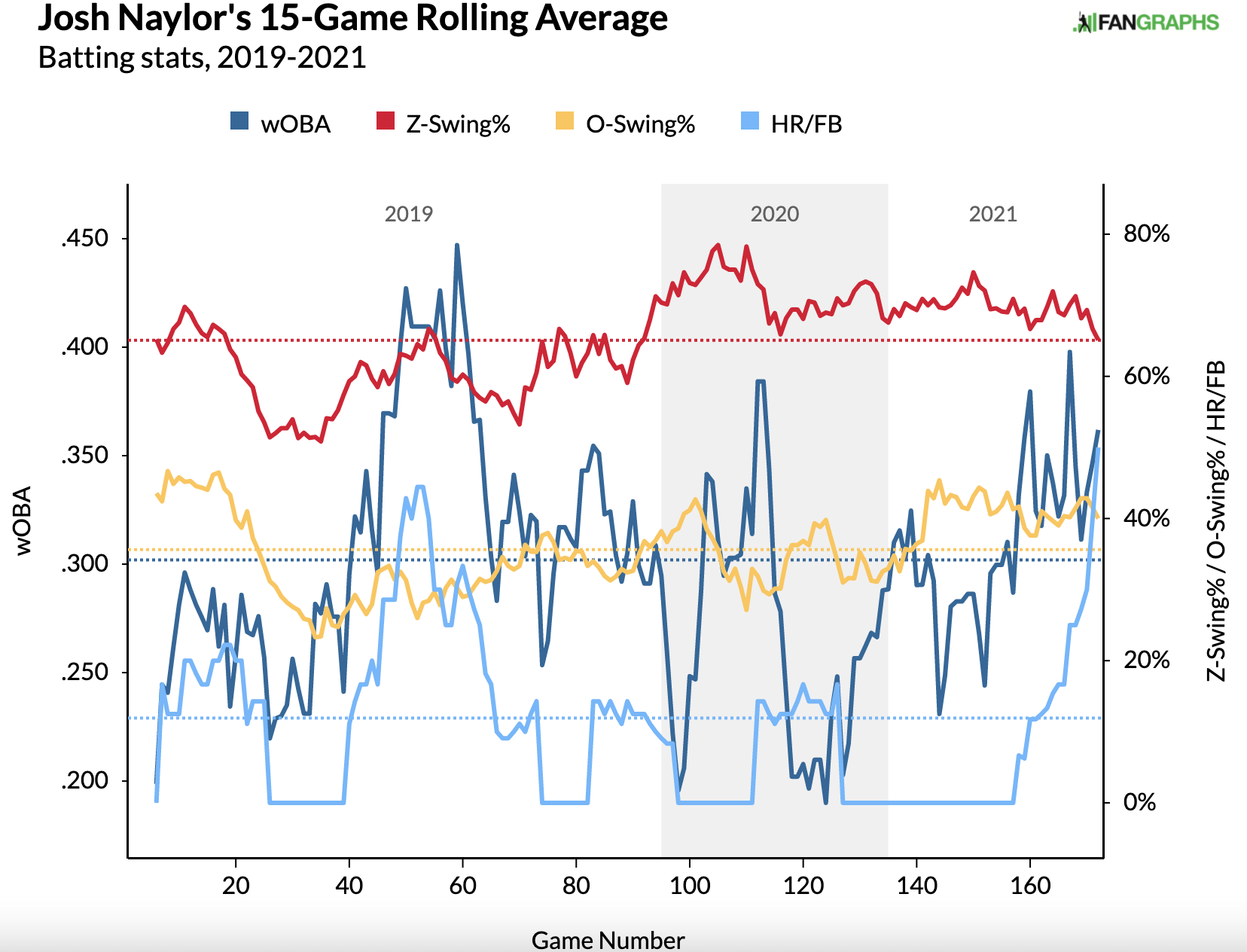
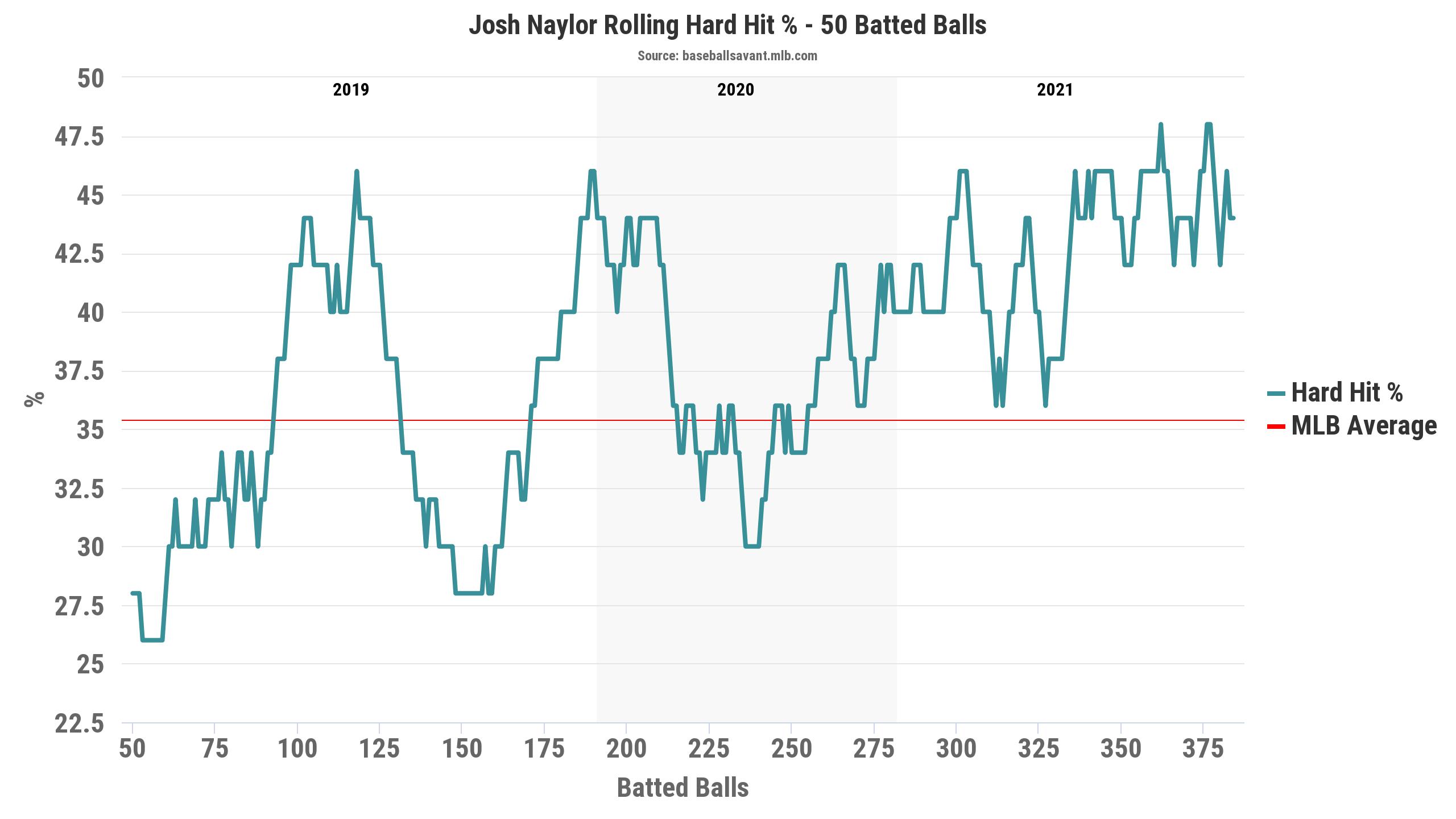
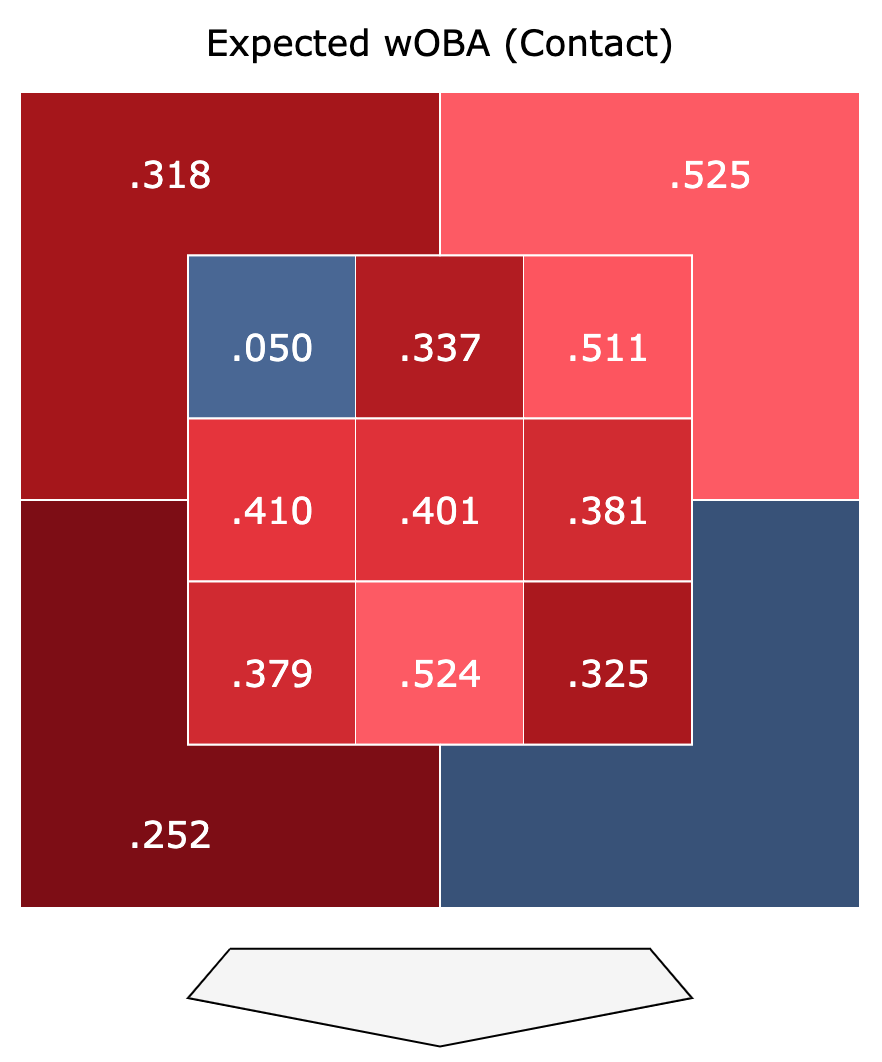
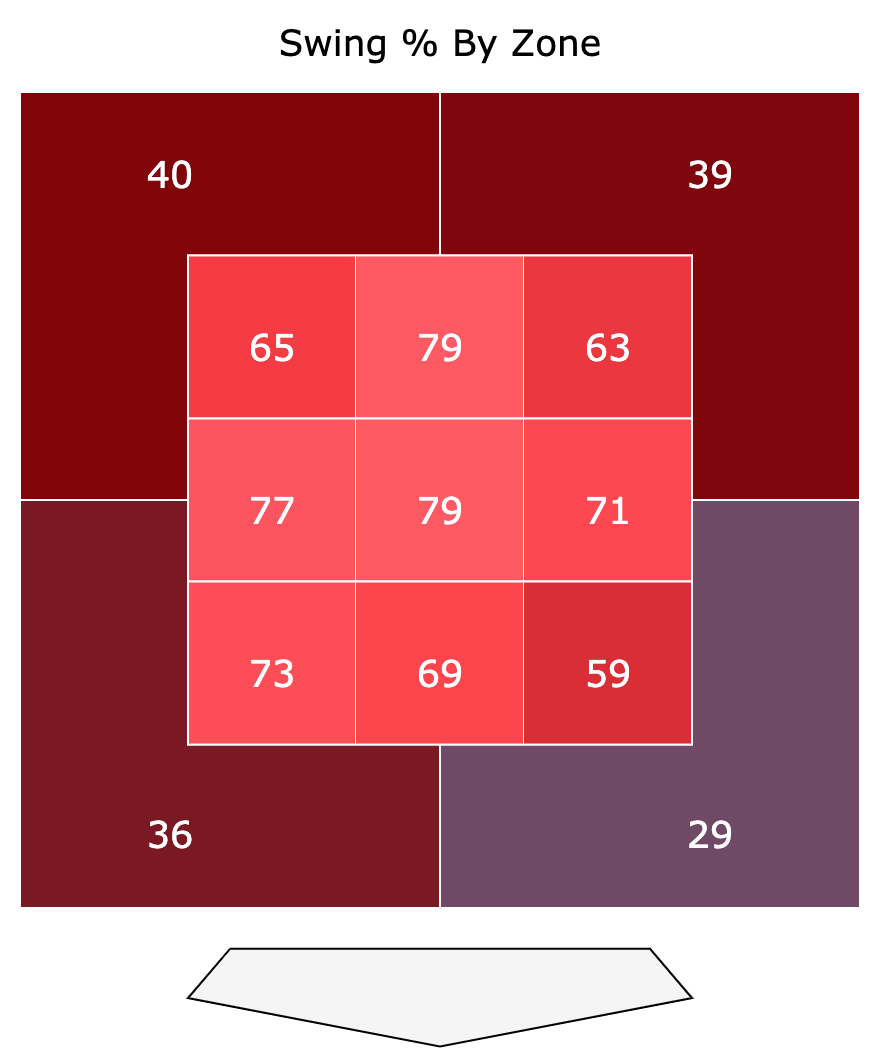
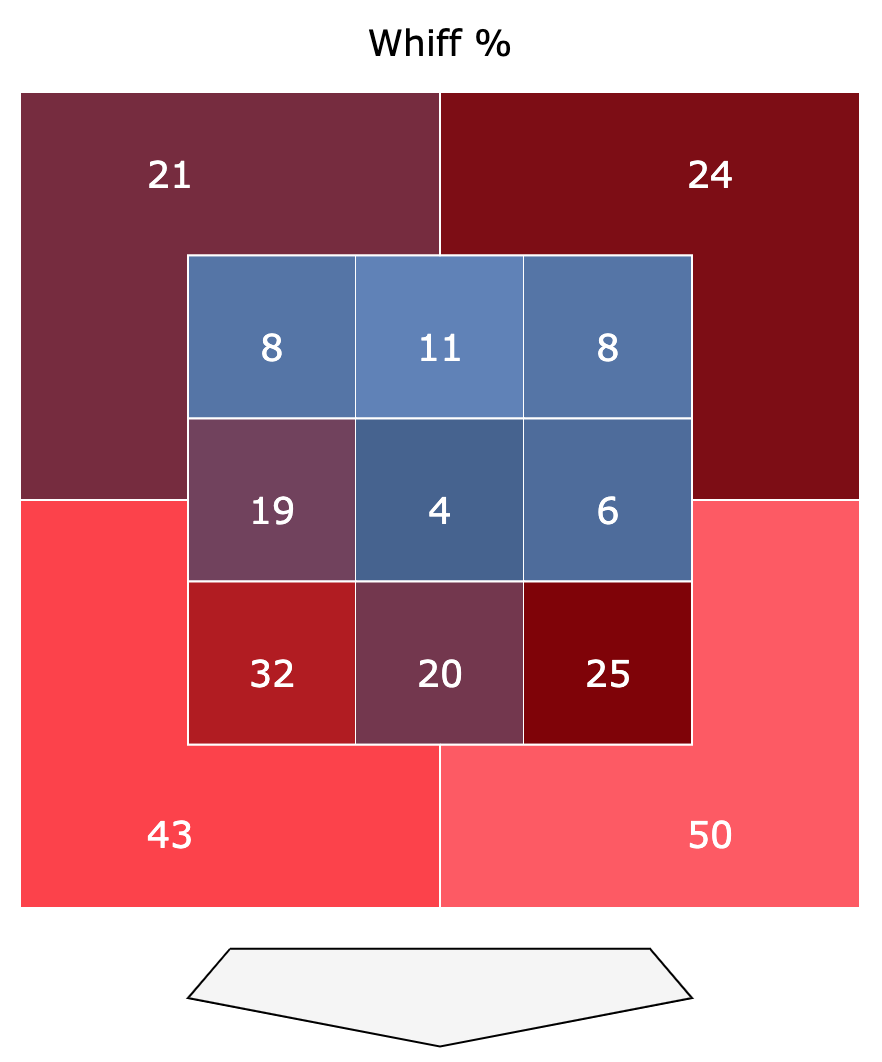
Great piece, Chad. Would you grab Naylor over Duval? I grabbed Duval as a replacement for Trout, but if Naylor is going to be better in the long run, I’ll take a shot.
I definitely prefer Naylor. I think he has more upside.
Sounds good. I actually found a way to get both. I dropped Fuentes, who was a streamer in Colorado anyway. Thanks!
In a 12 team roto mixer w/ 5 OFs and CI, do you like Naylor more than Pavin Smith or A. Hays ROS?
Definitely Pavin, as I think there is job security risk with Pavin that doesn’t exist with the other two AND I think he projects to be the least productive of the three.
Hays is closer, but I still lean Naylor. They project to be similar – better average from Naylor, couple more SB from Hays – but I think Naylor has another level of power he could unlock. I also think Naylor will find himself hitting higher in the lineup sooner rather than later, and hitting around JRam and Franmil could do wonders for his counting stats.
Clarification: Definitely Naylor over Pavin. I realize that “Definitely Pavin” was pretty unclear.
Vaughn v. Naylor?/
Forgot to include…What about v. A. Vaughn?
That’s tough cause I think Vaughn has big upside but I’m not sure how quickly he reaches it. Redraft probably Naylor but I imagine a lot of people would disagree.
He’s been on my watchlist for a while, but I’m not seeing him “breaking out,” per se – he’s a breakout candidate if he shifts the way you’re suggesting. IMO only an add in deep leagues or as an injury replacement when you think there’s a good chance your first pick will be coming back relatively soon unless we see shifts in the directions described.
33Ks 6BBs in a league with -1 per KO he is pretty useless. Plenty of guys performing better with fewer ABs.
Appreciate what you guys do bro. H2h 15×15 points league (keeper). Been holding Andrew Vaughn all year and he’s killing me. Have 5 IL spots filled and can’t fit Alonso and Walker either. Pitchers have dominated thus far but a hot hitter on a great day nets you 20 points maybe while a pitcher with a QS can get you 50. Would u drop Vaughn for a guy like Manoah who looks filthy or add Naylor? We lose points for Ks, gidp and errors. Also guys like Josh Rojas are available. My OF right now is adolis Garcia, Chris Taylor (2b), Austin hays, Willie Calhoun, laureano, trey Mancini, kiriloff, bader (util), with springer and A. Marte on IL.